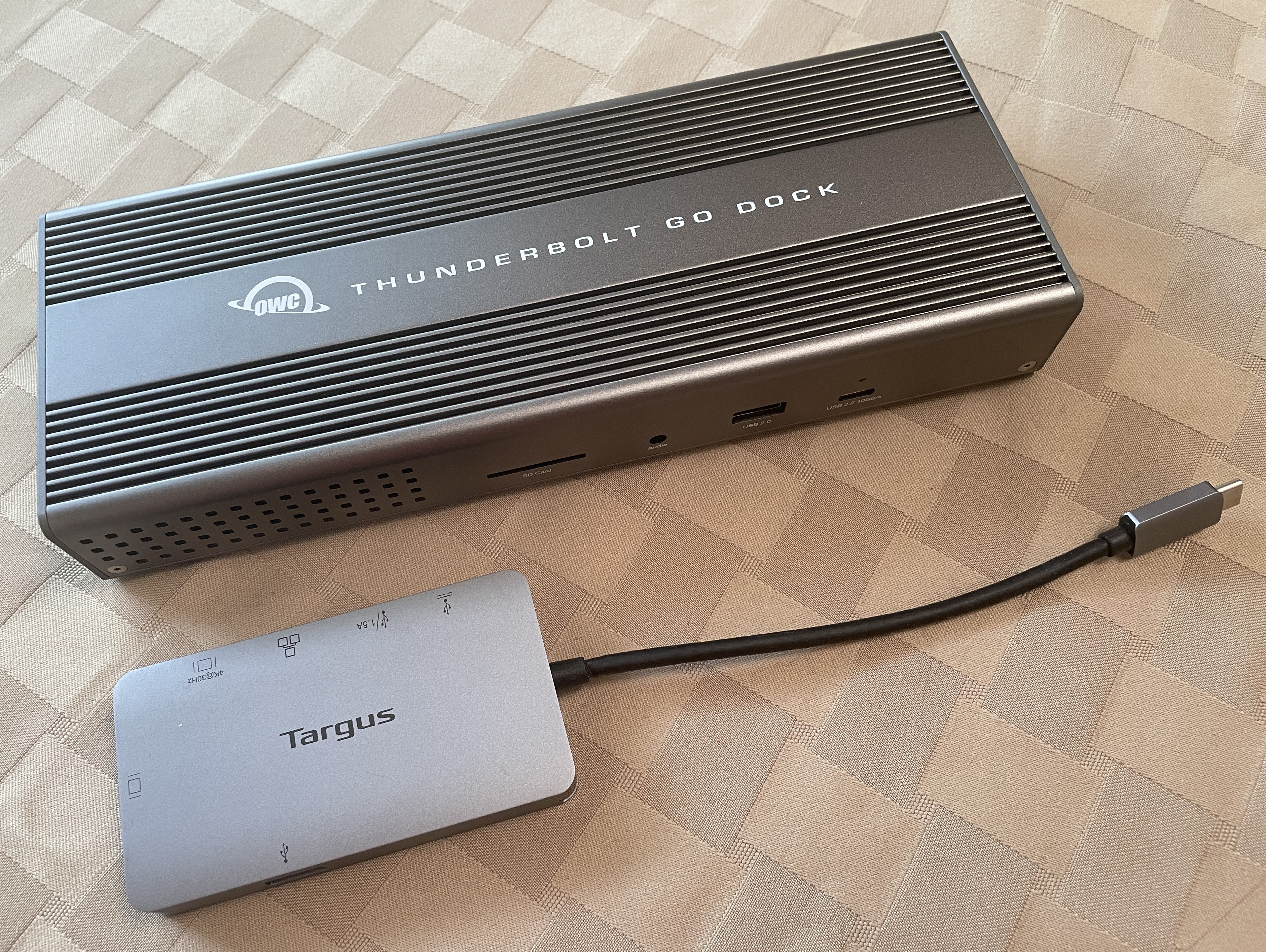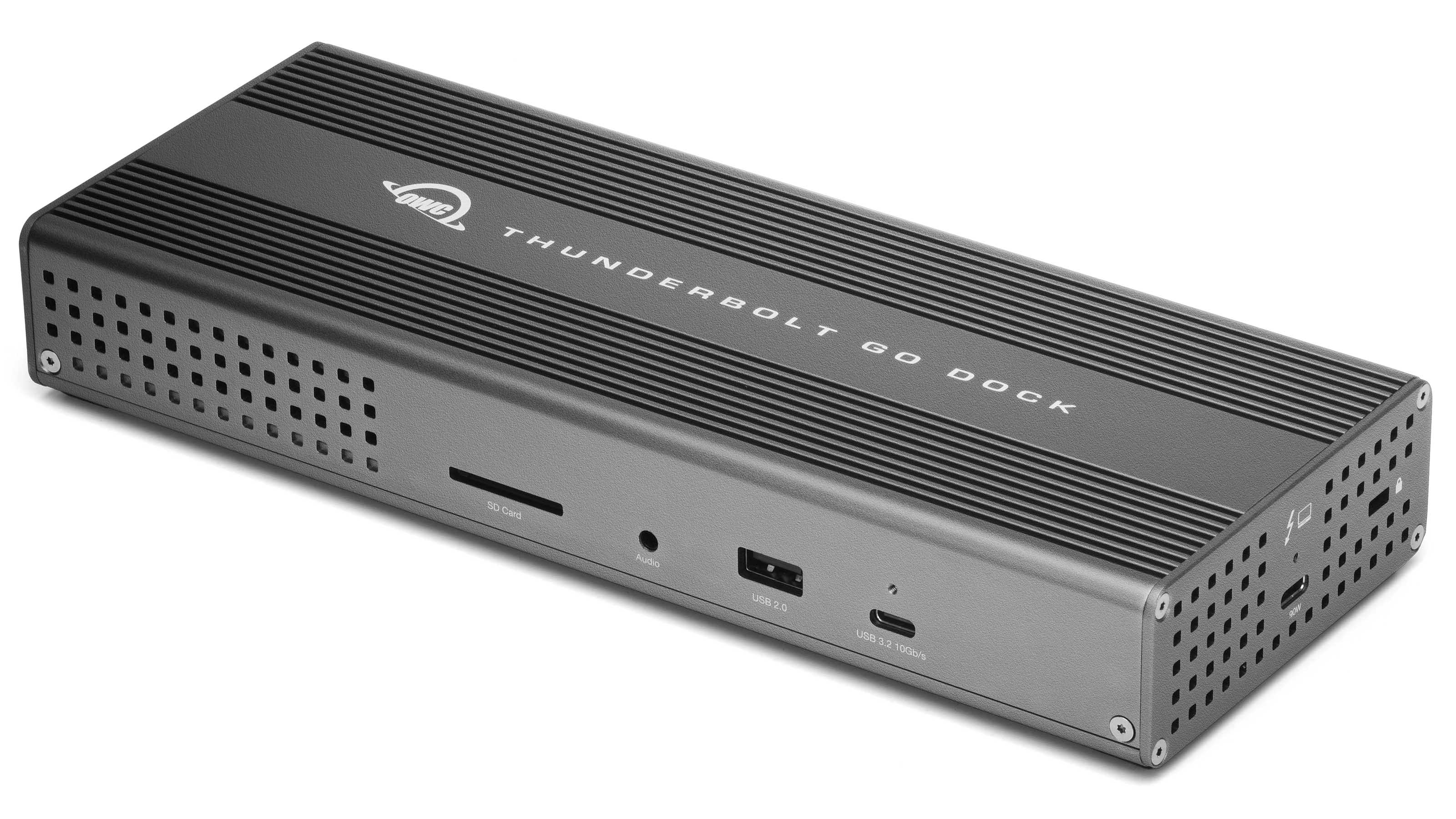First, let's be clear: I really do like my company-issued Microsoft Surface laptop. Its Intel i5 processor is not going to win any performance competitions, but for checking email, writing content, researching on the web, and the occasional Photoshop work, it's more than adequate.
That said, its connectivity options stink.
There's a proprietary power port on one side, and only a headphone jack, one USB-A, and one USB-C port on the other. That means no integrated HDMI port for an external monitor, no Ethernet port for a wired internet connection, and not enough options for connecting external devices. If I want to work the way I want to work—that means using my Samsung widescreen monitor, MAXHUB speakerphone, Jabra USB camera, and an external keyboard and mouse fed through a Belkin secure KVM switch—I need a dock.
[SCN Hybrid World Review: 3 Reasons to Love the Audeze Conference Speaker]
OWC recently introduced the Thunderbolt Go Dock. You may think "Thunderbolt" implies it's designed for a Mac, but plenty of PCs these days have Thunderbolt ports. It's about 9.5 inches long and more than 3.5 inches wide, and that's before you actually connect anything. Basically, the unit is about four times larger and twice as thick as my Targus DOCK419B dock, and it weighs a touch over 2 pounds.
Pick Your Port
The problem with some smaller docks is the lack of inputs. For example, I have an off-brand dock with one HDMI, three USB-A, one USB-C, and an SD card port. Not bad; in fact, I use it in my home office instead of the Targus dock that was issued with my company laptop. When I'm on the road, though, I need an Ethernet port, so it's back to the Targus.

That's the thing about docks, isn't it? You need to determine what connectivity you need and start your search from there. What I like about the Thunderbolt Go Dock is that it's got plenty of everything, and I appreciate how the ports are distributed.
Yes, you want most of your connectivity in the back for aesthetics and cable management, but sometimes you just need to plug in a USB stick and copy a few files. On the front panel, OWC included one USB-A port, plus a USB-C port and audio jack. The front panel even has an SD card reader, so it's easy to download video footage or stills from your DSLR. It's convenient without being messy.
[SCN Hybrid World: Look Up, Listen Up with These 9 Ceiling Mics]
The rear panel is loaded with ports: two Thunderbolts (look for the lightning bolts) that can also be used for USB-C displays or USB devices, two USB-A, one HDMI that supports up to one 8K or two 4K displays, and a 2.5 Gbps Ethernet port, which is an upgrade from the 1 Gbps port found in other docks (and some laptops).
There's an additional Thunderbolt port on the side, which provides access to the built-in power supply. It delivers up to 90W of charging power for any laptop or tablet that supports power delivery via Thunderbolt, including my Surface, so you don't need to pack your power supply on the road.
Speaking of power cables, the Thunderbolt Go Dock itself does not have a proprietary power cord; it's easy enough to find a "figure 8" two-prong power cord if you misplace it. There's also a Kensington lock slot, which technically isn't a port but does provide a handy anti-theft option.
Power and Versatility
The Thunderbolt Go Dock instantly created feelings of dock envy. So, being a mature and responsible product reviewer, I decided to break it. I plugged in my 4K USB camera, USB speakerphone, and HDMI external monitor, along with my mouse and keyboard. Next, I opened a Google Meet and streamed music on YouTube while I accessed images from an SDHC card. Plus, I charged my Apple Watch using one of the available Thunderbolt ports in the back.

Oh, my computer's internal fan got a workout—there was a lot of processing going on—but the Thunderbolt Go Dock didn't miss a beat. The dock has a fanless design, so it also didn't make a sound.
Later, I attached an iPad to the dock, which meant I was able to use it with my USB keyboard and mouse, as well as other connected items. Depending on your workflow, this could be a serious game changer.
[SCN Hybrid World Review: Check Out the View]
I did have to use the 90W Thunderbolt port on the side to connect the dock to my computer or tablet. This is not a deal breaker; in fact, OWC told me the Thunderbolt Go Dock is Intel certified, and that certification requires a dedicated port for uplink. The dock also got a little warm—not hot, there is a difference—but no worse than my laptop (or other docks), even when I left it plugged in for days.
With a street price near $350, the Thunderbolt Go Dock is not an inexpensive option—you can find plenty of those online. Instead, it's a solid piece of equipment with a built-in power supply and a versatile selection of ports, whether you use a Mac or a PC. The aluminum chassis is designed to withstand your commute, but it looks professional on your desk. You just won't find all that in a low-cost dock.

